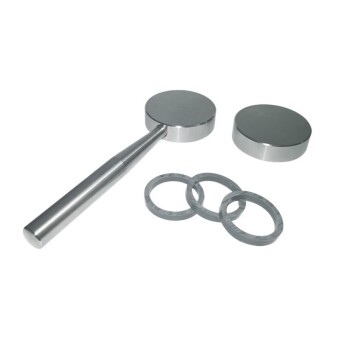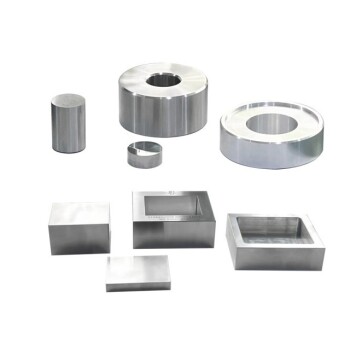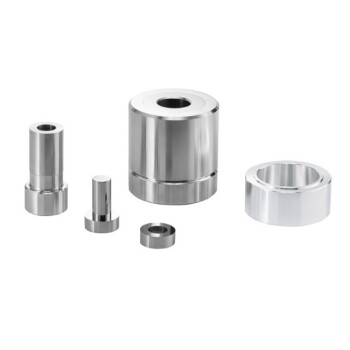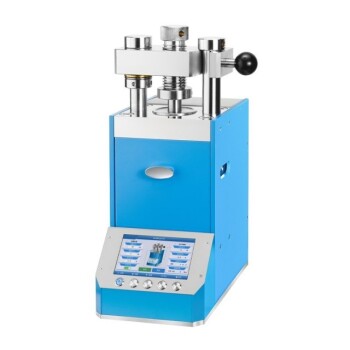At its core, the KBr pellet method achieves high sensitivity in IR spectroscopy by creating an ideal environment for analysis. It suspends a tiny, uniformly distributed amount of your solid sample within a transparent matrix, maximizing the interaction between the infrared beam and your sample molecules while simultaneously eliminating background interference.
The sensitivity of the KBr method is not inherent to the technique itself, but a direct result of meticulous sample preparation. By perfectly dispersing the sample in an IR-transparent medium, you ensure that even weak molecular vibrations from trace components can be detected clearly.
The Core Principle: Maximizing Signal, Minimizing Noise
The goal of any spectroscopic technique is to get the strongest, cleanest signal from the sample with the least amount of "noise" or interference. The KBr pellet method is engineered to do exactly this for solid samples.
KBr as an "Invisible" Matrix
The choice of potassium bromide (KBr) is deliberate and critical. KBr is transparent to infrared radiation across the most commonly used mid-IR range (4000-400 cm⁻¹).
This means the KBr itself does not absorb IR light in this region. It acts as an "invisible" window, allowing the spectrometer's detector to see only the absorption bands from your sample molecules.
Furthermore, KBr is a relatively soft, crystalline salt that is chemically inert, so it won't react with most samples during preparation.
Creating a Uniform Sample Dispersion
High sensitivity hinges on ensuring the IR beam interacts consistently with the sample as it passes through the pellet. This is achieved by grinding the sample with KBr powder.
This process breaks down the sample into microscopic particles and distributes them evenly throughout the KBr. Without this, the IR beam might pass through a clump of pure sample (saturating the signal) or a clump of pure KBr (missing the sample entirely), leading to a distorted and unrepresentative spectrum.
Path Length and Concentration Control
The Beer-Lambert law dictates that absorbance is proportional to concentration. The KBr method gives you precise control over this.
By carefully weighing the sample and KBr (typically a 1:100 ratio), you create a known, dilute concentration. This prevents the strongest absorption bands from being too intense ("off the scale") while making weaker bands more prominent and easier to analyze.
This control is what allows the method to be used for detecting trace components or impurities.
Understanding the Trade-offs and Common Pitfalls
While powerful, the method's sensitivity is dependent on proper technique. Several factors can compromise your results if not managed correctly.
The Critical Threat of Moisture
Potassium bromide is hygroscopic, meaning it readily absorbs moisture from the atmosphere.
Water has very strong, broad absorption bands in the IR spectrum (around 3400 cm⁻¹ and 1640 cm⁻¹). If your KBr is not perfectly dry, these water peaks can obscure or completely overwhelm the signals from your actual sample, ruining the analysis.
Using oven-dried KBr, storing it in a desiccator, and working quickly are essential for high-quality results.
Pressure-Induced Changes
The high pressures (8-10 tons) used to form the pellet can sometimes alter the crystalline structure of the sample, a phenomenon known as polymorphism.
This can cause shifts in the peak positions or shapes in the IR spectrum. The resulting spectrum is still valid for the sample in that state, but it may not perfectly match a reference spectrum of the material in its native crystalline form.
Inhomogeneous Mixing and Particle Size
If the sample is not ground finely enough, light scattering can occur. This leads to a sloping baseline and reduced spectral quality, a common issue known as the Christiansen effect.
Poor mixing results in a non-uniform pellet, making the analysis unreliable and non-quantitative. A good pellet should appear clear or uniformly translucent to the naked eye.
Making the Right Choice for Your Goal
To leverage the high sensitivity of this method, your preparation must match your analytical objective.
- If your primary focus is detecting trace components: Prioritize using exceptionally dry KBr and grinding the mixture meticulously to ensure maximum signal clarity and avoid interfering water peaks.
- If your primary focus is quantitative analysis: Emphasize precise and accurate weighing of both the sample and KBr to create a known, reproducible concentration for every pellet.
- If your primary focus is identifying an unknown solid: Concentrate on achieving a fine, uniform particle size and a clear, transparent pellet to produce a clean spectrum free from scattering artifacts.
Mastering this technique transforms a simple salt and a press into a powerful tool for obtaining reliable, high-fidelity molecular information.
Summary Table:
| Key Factor | Role in Sensitivity |
|---|---|
| KBr Transparency | Acts as an invisible matrix, allowing IR beam to focus on sample without interference |
| Uniform Dispersion | Ensures consistent interaction with IR light, reducing noise and enhancing signal clarity |
| Controlled Concentration | Prevents signal saturation and makes weak bands detectable for trace analysis |
| Moisture Management | Avoids water absorption peaks that can obscure sample signals |
Unlock precise and sensitive IR spectroscopy results for your laboratory with KINTEK's advanced lab press machines. Our automatic lab presses, isostatic presses, and heated lab presses are designed to ensure uniform KBr pellet formation, minimizing moisture issues and maximizing analytical accuracy. Whether you're detecting trace components or conducting quantitative analysis, KINTEK's equipment delivers reliability and efficiency. Contact us today to discuss how our solutions can enhance your lab's performance and meet your specific needs!
Visual Guide
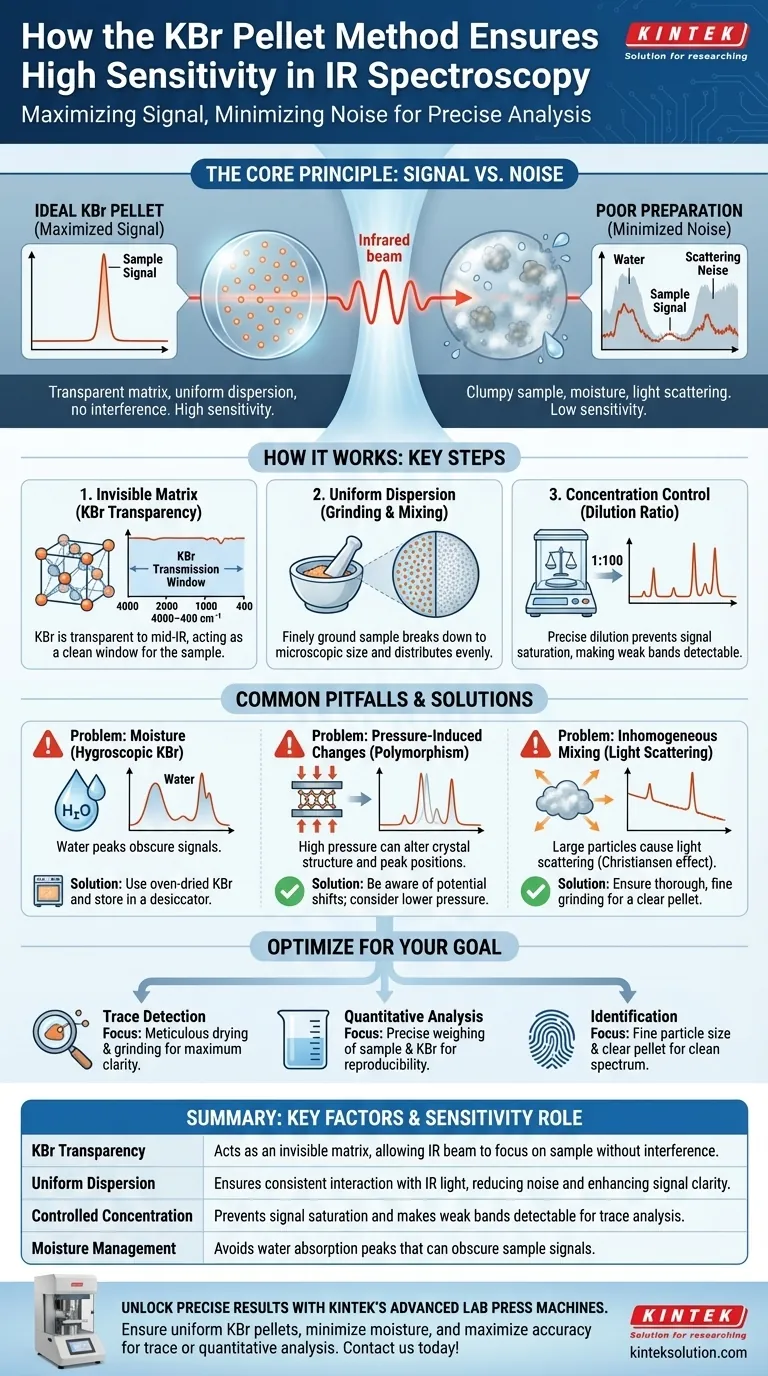
Related Products
- Automatic Laboratory Hydraulic Press Lab Pellet Press Machine
- Manual Laboratory Hydraulic Press Lab Pellet Press
- Laboratory Hydraulic Split Electric Lab Pellet Press
- Laboratory Hydraulic Press 2T Lab Pellet Press for KBR FTIR
- Automatic Laboratory Hydraulic Press for XRF and KBR Pellet Pressing
People Also Ask
- What are the key steps for making good KBr pellets? Master Precision for Flawless FTIR Analysis
- How do hydraulic pellet presses contribute to material testing and research? Unlock Precision in Sample Prep and Simulation
- How does a hydraulic press aid in XRF spectroscopy? Achieve Accurate Elemental Analysis with Reliable Sample Prep
- How are hydraulic pellet presses used in educational and industrial settings? Boost Efficiency in Labs and Workshops
- What is the purpose of creating pellets for XRF spectroscopy using a hydraulic press? Ensure Accurate and Repeatable Elemental Analysis









